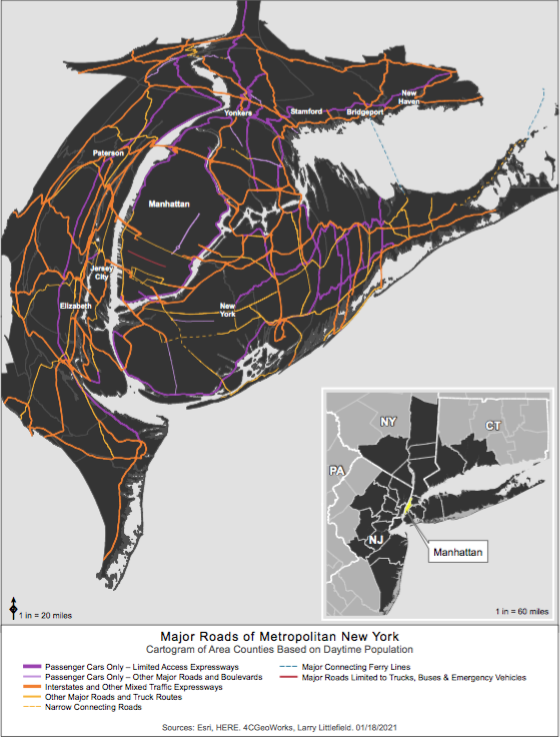Car drivers in the New York metropolitan area have more exclusive room to roam than do their counterparts in any other area of the country. That’s because, as the cartogram above shows, our metropolitan area contains the nation’s most extensive limited-access expressway system (shown in purple) — roads that are restricted to passenger cars only.
No trucks, buses, or commercial and service vehicles allowed.
As a result, the extent of New York’s passenger-car-only expressways far outstrip the networks of car-only roads in any other metro area, almost all of which have none, according to policy wonk (and frequent Streetsblog commenter) Larry Littlefield, who commissioned the cartogram from the Pittsburgh-based firm 4CGeoworks. Metro Washington, D.C., has an expressway network limited to passenger cars — but it’s not even close to the extent of ours.
New York’s passenger-car-only expressways are a relic of our status as the wealthiest state in the earliest days of the automobile, when many of these “recreational” roads were erected. Our earliest parkways — the Bronx River, Hutchinson River, Saw Mill River, and (the original) Cross County — predate even Robert Moses. (Moses later copied those roads on Long Island, which got us the Northern and Southern State, among others, and in New York City.) But the legacy of having so many car-only roads has distorted metropolitan transportation planning ever since.
“Having many of those expressways restricted to a limited class of road users is a unique and extraordinary privilege, one that puts proposals to allocate a greater share of the space on other mixed-traffic roads to bicycles, buses, trucks and other commercial vehicles in perspective,” Littlefield writes in a long blog post.
Among other distortions, it explains a great deal of the downstate area’s chronic congestion: Prohibiting commercial vehicles on so many limited-access, grade-separated roads means that truckers and van drivers spend hours stuck in traffic, driving up the cost of freight exorbitantly and forcing many trucks on to local streets where drivers may encounter cyclists and pedestrians. The prohibition of bus traffic on the same expressways explains why most intercity bus traffic originating in New York City must leave from Manhattan and head into New Jersey before traveling to points north in New York, and buses traveling east to New England face circuitous routes and long delays.
Given that New York car drivers have so many of their own roads on which to play, Littlefield believes that transportation planners should consider restricting private passenger-car access on other mixed-traffic expressways and streets, such as the crumbling portion of the Brooklyn-Queens Expressway that needs to be rebuilt (and is a heavy truck route). [Scott Stringer has made such a proposal.]
Some lanes on the Van Wyck Expressway, and part of the Cross Bronx Expressway, also key routes for freight, deserve the same treatment, Littlefield says.
To get around the latter road, "private passenger cars traveling between Long Island and New Jersey could take the Grand Central Parkway to the RFK/Triborough Bridge, and then travel up the Harlem River Drive to the G.W. Bridge," Littlefield writes. "Those traveling between Long Island and Upstate New York could take the Hutchinson River Parkway to the Cross County Parkway, or the Bruckner Expressway to the Bronx River Parkway. Commercial vehicles don’t have those options."
Given how many Metro New York expressways are available only to passenger cars, more bicycle infrastructure on mixed-traffic streets can hardly be considered inequitable to drivers.






